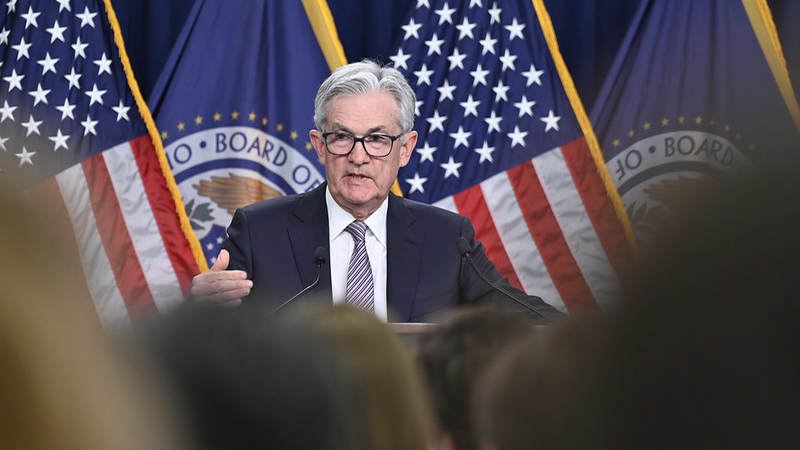Monday 16 September
- First-half results from Phoenix Group, Wilmington and Keywords Studios
- Rightmove UK house price index
Tuesday 17 September
- Full-year results from Ferguson, McBride and Springfield Properties
- First-half results from IP Group, Henry Boot, Petershill Partners, Trufin and Good Energy
- German ZEW economic survey
- US retail sales
- US industrial production and capacity utilisation
- US NAHB house building industry survey
Wednesday 18 September
- Full-year results from PZ Cussons and MJ Gleeson
- First-half results from MC Saatchi and Xaar
- Trading statement from Moonpig
- UK inflation
- EU inflation
- US building permits
- US building starts
- US oil inventories
- In the US, quarterly results from General Mills
US Federal Reserve decision
The US Federal reserve will announce its interest rate decision 18 September with analysts expecting the Fed to make its first rate cut of the year.
While a rate cut seems likely following Jerome Powell’s speech at the Jackson Hole Symposium, there is debate over if the cut will be 25 basis points or advance to 50 basis points. According to CME Fedwatch, as of Thursday 12 September, there was about a 71% chance of a 0.25% cut and a 29% chance of a 0.50% cut to an interest rate of 5%.
Russ Mould, AJ Bell investment director, Danni Hewson, AJ Bell head of financial analysis and Dan Coatsworth, AJ Bell investment analyst, said: “At first glance, a first cut in the Target Fed Funds rate since March 2020 seems to be in keeping with the core narrative that is doing so much to boost equity and government bond markets alike, namely that inflation will cool, economies will enjoy a soft landing (if indeed there is any landing at all in the US) and that central banks will therefore be able to cut the headline cost of money.
“Those rate cuts are in turn expected to stimulate demand for credit and thus economic activity, boost corporate earnings and cash flows thanks to higher demand (and lower interest bills) and persuade investors to take more risk, with asset classes such as equities, as the yield available from cash and fixed-income decline.”
In the past, the US Federal Reserve has supported the markets through events including the Russian Debt Default, the Great Financial Crisis, and the US banking issues in 2023 following Silicon Valley Bank. On average since 1971, in a two-year view following the first rate cut in a cycle, the S&P 500 has returned 20.3%.
However, the AJ Bell team warned that this is simply an average, and said investors “may need to be a little careful what they wish for”.
“First, equity markets do not always initially respond favourably to rate cuts, not least as they have had time to price in the first moves, and volatility often ensues, as markets also assess the reasons for the reductions. Victory against inflation can be seen as a good thing, but anything that be seen as an effort to stave off a recession or a financial crisis may get a much cooler reception,” Mould, Hewson, and Coatsworth said.
The team also recalled instances, in 2001 to 2003 and 2007 to 2009, where rate cuts did not avoid recession due to poor corporate earnings.
“The Fed has cut by an average of four-and-a-half percentage points from peak to trough during a typical downcycle. That is more than markets are expecting this time around, given that interest rates are currently forecast to bottom after around two-and-a-half percentage points worth of cuts, to suggest that share and bond markets could be underestimating how far central bankers may move – to the potential detriment of equities — if they have to go that far, then an unexpected economic downturn would presumably be the most likely cause — and benefit of fixed-income (at least unless stagflation takes hold),” the AJ Bell trio said.
Next first-half results
Retailer Next will release its first-half results on 18 September, following an August trading update which revealed 3.2% growth for the second quarter, coming in above expectations.
Currently, chief executive Lord Simon Wolfson has announced guidance of a 3.4% increase in full price sales for the year. However, the first half outpaced its 2.5% growth expectation, instead increasing by 4.4%.
“At its core, retail is about selling the right product at the right price point in the right format for the target customer base. Doing this correctly will improve stock turn and sell through, reduce the need to discount and in turn help profit margins and cash flow. Get it wrong and the opposite will happen – excess inventory will have to be shifted to the detriment of margin and profits,” Mould, Hewson, and Coatsworth said.
“Next seems to have the knack of getting this right and in this respect its key performance indicator (KPI) of growth in full-price sales is particularly helpful.”
Pre-tax profits guidance for the year is now £980m for the year, compared to last year’s result of £908m.
Thursday 19 September
- Full-year results from Close Brothers and Galliford Try
- First-half results from Judges Scientific and S4Capital
- Trading statement from Ocado
- Bank of England interest rate decision
- German Ifo economic survey
- US existing homes sales
- US weekly initial unemployment claims
- In the US, quarterly results from FedEx, Lennar and Darden Restaurants
Friday 20 September
- GfK UK consumer confidence survey
- UK Government borrowing
- UK retail sales
- Chinese one-and five-year interest rates
- Chinese monthly retail sales, industrial production and fixed asset investment growth
- Bank of Japan interest rate decision











